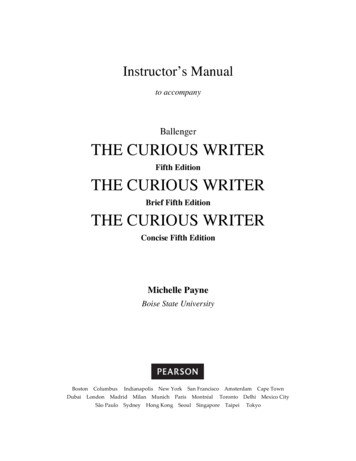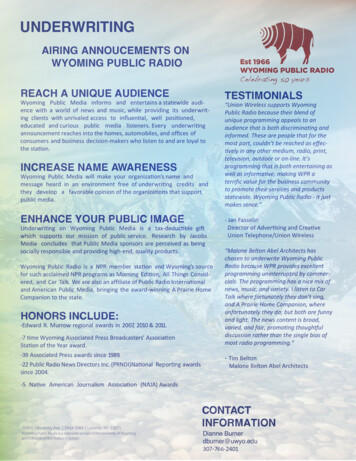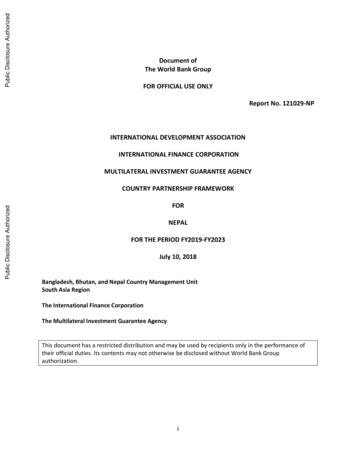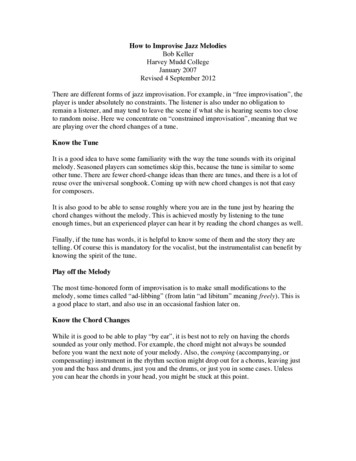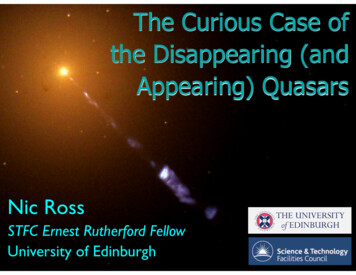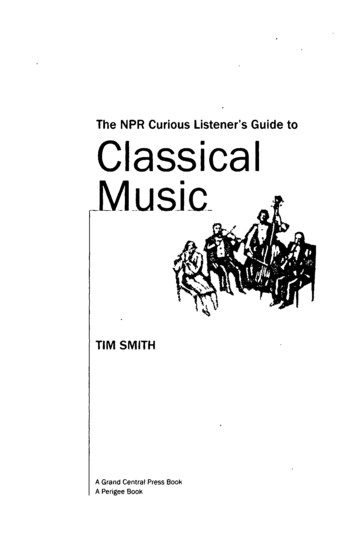
Transcription
The NPR Curious Listener's Guide toClassical.MusicTIM SMITHA Grand Central Press BookA Perigee Book
The NPR Curious Listener's Guide toClassicalMusic
The NPR Curious Listener's Guide toClassical.MusicTIM SMITHA Grand Central Press BookA Perigee Book
" Perigee BookPuhhshed by The Berkley Pubhsluug GroupA drvrsion of Pengum Pumain lncH5 H udson StreetNe-w Vork, :\ew York 10Cl14Produced by Grand Centra] "re«Paul Forgas. Director.Iudy Pr ay. Execun ve Ed 11",l\lC'k \',orst, Series Ed,tOJNATIOi'o,\L PUII.le II.-\I)j( IMurray Horwuz, Vrce-Presidenr, Cultural ProgrammingAndy Trudeau Execuuve Producer, Culmral ProgrammingBenjamm Roe, Senior Producer, Special Projecr-, Cultural ProgramrmngBarbara A Vrerow. Project \Ja"ager, Bus"IC" Developrnen.Kate F.lhOtl, PrO)E"f:( \lanagpr, Rll,)H1f'S 1)f'\r\oplnPIlINPR, opr, and Nanonal Public Hadlo 'HP Sp')\'I('P marks 01 '\;\t1onal P\lhhr. Harhn, lnrand may not bp used wu hnut thp pp.rrlll')!ann of ,PR.Copynght JOCl9- by (hand Cenrral Press and 'vanonal Puhlll' Radar Text cleSlgn by 'I.ffany K"k,"Cover rleSlgn by .lrll Boltmf :"\,("f a r t 11)" Dau R xtp.rAll nghts re-served Ttus book, or part' thereofmay not be reproduced tII anv form wn hour permlc;colOJl.VISHour wf"ho;1tp at ww w.pt;ngmoIIlHnam r-omSmith, TrmThe NPR cuneus l",eupr', gllldepIr r ]ass",,,1music / Tirn SrmthCIllIncludes IndexISBN 0·399·52795 IlI Music apprec,aw,nMT90 565 20097111 n'Il' ·rlc21I "atlonal Puhhc' Rad,o It.' S )11 T,tle20010551n2plll"1l:n10I 9I'm. r"IIF.!) S1.\IE" (,IR7\\If-I\IL\I
1.What Is Classical Music?12.The Story of Classical Music73.Varieties of Classical Music334.Classical Music Deconstructed515.The Composers876.The Performers1:/77. The Music1518.Classical Music on CD1919.The Language of Classical Music215Resources for Curious Listeners227Index233
AcknowledgmentsMy thanks, first of all, to the late music lustoriau and photoarchivist OUo Bdllnallll,'wllO kept encuuraging me to write ahook; I'm sorry it Look me so long to folluw his advice. Andthanks tu my parlner, Hobert Leiuinger, for pushing me tofinish the product and helping' me ill various ways durillg theprocess.Another round of t h.mks tu my editor, Nick Viorsi, for hisremarkable pat.ir-uce alld good judgment. Aud to MichaelTilson Thomas tor his invaluable foreword, 1I0t to mentionthe Illauy years of inspiration his ever-curious musical mindhas given me. I also grt·atly appreciate all the folks at NPH,especially Bell Hoc, who endorsed my part icipat ionproject.IIIthis
Forewordby Michael Tilson ThomasNPR is one of America's greatest cultural resources, Its spiritof operi-m iuded inquiry into the nature of things has madeit all informative and entertaining part of our lives. It is thesty le of NPR lo offer a fresh and direct approach tu all t be areasof its wide-ranging curiosity. It makes us aware of so wallY newthoughts, as well as bringing us new insights into t ose thatare familiar.With this guid , NPR fans will have the «hance to discoverrefreshing new perspectives about Western civilization's mostabstract and emotionally affecting art: classical music. ClassicalIn usic, for oue thousand years, has expressed mail's most personal thoughts about God, life, love, despair, fantasy, rage, resiguation, and JOY- the whole gamut of what it means to bealive.There's IlU other music that has the rauge and diversity ofclassical music. Its rich tradition can be all intricate tangle ofIX
x Forewordstyles, forms, COlll posers, 'artists, and aesthetic movements. Yetat all times it has SUllg and witnessed profoundly and directlythe beautiful bittersweetness of being.This guide, written by the enthusiastically witty and knowledgeable Tim Smith, offers the reader insights into classicalmusic's mysteries, while at the same time clarifying its centralsincere purpose of communication and expression. I think you'llfind it a welcome addition to your library.Michael Tilson Thomas assumed his post as the San FranciscoSymphony's elenerult music director in September 199 , consolidating a strong relationship with the Orchestra that began withhis debut there in 1974 at the age 0/ twenty-nine. Along with hispost .in San Francisco, Michaei T'iison Thomas serves as artisticdirector 0/ the New World Symphony, a national training orchestra for th« most gifted graduates of America's conservatories,which he founded in 1988, and as principal guest conductor !fthe London Symphony Orchestra, where he served as principalconductor for seven years.
IntroductionClassica l music is a source of inspiration, exhilaration, andcomfort to sorne people. To others, it's all intimidatingmystery, or maybe even an extreme annoyance.Not long ago, a story appeared about how West Palm Beachpolice started piping in the greatest hits of Bach, Mozart, andBeethoven twenty-four hours a day from all abandoned buildingin a neighborhood being overrun by drug dealers. That did thetrick. The place has never been safer. There have been similarreports over the years of r-lassiral music aimed at tf'enaged loiterers at convenience stores.The idea that the sounds of this aural art form could driveanyone away is almost as scary as a drug infested street corneror a bunch of kids blocking the way to a quick pick up of milk.It is a dispiriting sign of the times that classical music does notenjoy the widespread admiration, respect. and outright love itonce did, and that many young people, in partirular, find itXI
XII Introductionhard to take. The steady decline in music education in theschools certainly hasn't helped. The enormous allure and ornnipresence of pop music, combined with a general dumbingdown of culture, has also played a part,And yet, classical music endures. Its relative lack of popularity in no way diminishes its status as an integral part of whatwe call civilization. As such, this music will always have itsadmirers, will always attract the curious of all ages (even a fewrock stars interested in expanding their horizons), ethnic backgrounds, religious and poli t.ical persuasions, nat.ionalities, andorientations of one kind or another. Classical fans may not always be numerous, but they will be enthusiastic and loyal.What makes classical music worthy of exploration, let alonedevotion? What gives it such lasting power? All art forms in-volve some sort of qualitative evaluation. Few people wouldargue that the figures of clowns and Elvis painted on velvetand sold every weekf nd on gas station lots are equal in worthto the Mona Lisa or an abstract canvas by Jackson Pollack. Weknow instinctively that there is a difference in quality of artistryinvolved, even before we address the issue of price. We knowinstinctively why certain artwork ends' up on display in museums and why crowds flock to see it.It's much the same with music, although the differences arenot always as obvious as between those velvet paintings andRembrandts. A simple folk song, passed down t.hrough generations, is certainly art; Aaron Copland's Appalachian Spring,which incorporates a simple folk-hymn, is arguably a more so-phisticated form of art. A well-crafted pop song by Cole Porteror George Gershwin or Elton John or Sting is certainly art, too.Yet a song by Schubert or Schumann, with words by a poetrather than a lyricist. and music written for a classically trained
Introduction jnger,IS on auotherdllist ic levelXIIInot necessarily better, bUIdl:'arly airlling for sonu-t h ing gn·all'!". Likewise, symphonies andcomert os and string (1llarll'ls and oratorios all strive for a IIighartistic ground.Although classical 1I111Sic very much reflects its own time, itis simultaneously steeped in traditions that may stretch back forn'nl uries. That's onl:' n-ason it's «al k-d "classical." The neatthing about those traditions is that t lu-y have a way of speakingto Curious Listeners ill a remarkably direct, inviting way. Mozart may have died in 17 )1, but people bearing his music forthe first lime ill 1l:lYl or I J J I could understand it on at least afundarneutal level, could relate to it, wii h hardly any effort, asif it were freshly wriru-n. The me-lodie-s stick quickly in thehead; the harmoniesJJI;lk( perfect se nse; the rhythms are readily discr-rurhle.Subconsciously, at lilt· v,'ry least, vn- ill the Westefll worldare conne-cted to the roots of ddssicul music, for they are thesame roots that havecIassir.al aud popI'I"lH]IICl'dall of Western music. Music-v-IS cl"!'ated out oflilt'same twelve tones oft.he- s('ale tltat have y ir-lded the sarue chords for centuries, thesame twe-lve tunes that have also produced the complicated,dixsouaut sounds thatt'l"Ilptf din the twentieth century. Appre-ciating the common grollllJ shared by so many types of musicis one way for the Curious Listene-r to hecorne comfortable withthe dassi(·s.ThelIrgeto d!l4number uf ways.men-ialilllocLlssicalSOliil'l 11ill'S,(;1' movie scellt'wilII11lSIl"call be sparked ill allYit's lIothillg more than a TV rornh a classical rorn position ill the backgrolllld that hooks soun-oue's interest. A chalice encounter011the radio ran do the s.ut re. Smile pt·opl!: find themselves, evenagaillst their will, dwggl'd along by a spouse or buddy to a
xiv Introductionclassical concert-and end up liking what they hear. Thoselucky enough to have music courses at school may discover alot more pleasure in subsequent exposure than they had everimagined.Whatever the entry point, the Curious Listener will keepgoing and keep exploring. Learning to appreciate classical musicis, like most of the finest things,"a lifelong process and a lifelongdelight. Folks who get hooked on the catchy rhythms and colorful sounds of Vivaldi's The Four Seasons may well check outworks by his contemporaries of the Baroque era, Bach and Handel. Those who first come across the boldness and drama ofBeethoven's Fifth Symphony may find it a natural, almost unavoidable path to his other symphonies, his concertos, andmaybe piano sonatas. And from Beethoven, it can be an easyleap to Brahms, possibly even all the way to Mahler and Shostakovich.Every Fourth of July, someone hears Tchaikovsky's 1812Overture for the first time and gets caught up in the exhilarating rush. (Why Americans celebrate therr independence daywith a composition about the Russian defeat of Napoleon's armyis a subject for another book.) A logical move is to buy a recording of that stirring Tchaikovsky work, which, since it's notenough to fill an entire compact disc, means automatic exposureto other works, perhaps by Tchaikovsky or fellow Russians. Andthat, in turn, can lead in all sorts of directions.It's not that you will end up loving everything you hear;most listeners develop certain limits, specific areas of attractionand of alienation. That's perfectly normal. To some, Rachmaninoff is a kind of aural sex; to others, his music is thick goo.To some, Bach is the epitome of genius and perfection; to others, he sounds mathematical. To some, Mozart is pure heaven;
Introduction xvto others, pure ennui. Some lucky listeners can thrive on atonality; some only writhe in agony to it. Part of the fun is tryingout different composers, different styles, different sounds. Musicfrom any time period can connect with us, can entertain, intriguf' or deeply touch us. All it takes is curiosity, and the willingness to listen.This book makes no attempt to answer all the questions aboutclassical music, hut only to provide a basic (and subjective)guide to this endlessly rewarding topic. In addition to a look atthe meaning of the term classical music, there is a short historyof the art form and a necessarily selective list of importantcomposers, performers, and compositions. Nothing can take theplace of actual listening, and nothing beats listening in personat concerts, but recordings offer an easy, and sometimes veryaffordable, way of increasing knowledge and intensifying interest. So you'll also find a list of suggested recordings that represent some of the best r-lassical music, from the distant past upto the presf'nt.Whether you decide to delve much more deeply into thesubject or to maintain a casual relationship with the art form,the main thing is to get your ears wet and keep them open tothe possibilities that are out there, to go a little further thanjust the compositions that spark the initial curiosity and plea.sure, to test your own limits and tastes.So plunge right in. The music's fine.
The NPR Curious Listener's Guide toClassical.Music
ONEWhat Is .ClassicaJ. Mus!c-LIt \ IIOt !'Op musu-, hut it has lots of catchy tunes.It's not rod\ music, but it often has a good beat andyou call duure to it ,II's not folk 1IIIISII:, but it often contains folk sOllgs andrhyi lnns.It's not jazz, hutSOIlIt of it used to be improvised, and someof it still allows for freedom of expression. And an awful lot ofit shares a defiu iug characteristic of jazz - - a democratic senseof creative community.Classical music obviously means many things, ellCOTlll'asseslIIany expressions. Blit for a long time now, the term has beenalurost universally understood to mean a type of music in theWestern world t ha I is art first, entertainment second. So there'sall easy answertotlie question, "What is classical music?" It'sthe kind that doesn't make much money.That wasn't always the case. Time was when classical corn1
2 The NPR CUriOUS Listener's GUide to Classical Musicposers wrote for and were handsomely rewarded by ki!lgs andreligious leaders. Today, with pop music ruling tile world, classical music may have lost much of its marketability, but noneof its significance,The very word classical connotes something of lasting value,sornething conceived with certain standards ill mind. This hasled some people 1.0 slap an additional label onto such music-r-"elitist." But that's a cheap shot. There is nothing restrictiveabout classical music. Although it is best appreciated, mostdeeply understood, by those who study it ill some detail, it isessentially accessible to anyone with upen ears. And that act oflisteniug is a very important part of this art form. Despite itsuse in shopping malls and hotel lobbies, most classical music isintended to be foreground, not backgruund; it wants to be frontand center, not piped ill.The word classical conveys structural order, a dear sense ofform, design, ami content, this is. certainly part. of whut makesclassical music classical. It can be "seen " as well as heardlooked at as a kind of sonic edifice with a foundation, walls,stairways, and windows, The works of Joseph Haydn awlWolfgang Aruadeus Mozart suggest. perfectly proportionedeighteenth-century buildings; the ear call easily pick up the wayphrases are balanced in pairs, like the same number of windowson the left and right sides of a house. In the late-nineteenthcentury, Anton Bruckuer's very long symphonies confused manylisteners, but underneath the music were clearly organizedblocks of melodies and the mortar to bold them toget.her.Until the twentieth century, when composers began experimenting freely with form and design, classical music continuedto follow basic rules relating to structure, not to mention harmony. There still was room for individuality (the great corn-
WhClt I::. Classical MUSIc? 3p08ers d idri't lullow the rules, but made the rules follow them),yet there was always a fundamental proportion and logic behindthe design. Even after many of the rules were overturned byradical concepts in more recent times, composers, more oftenthan Hot, still organized their thoughts in ways that producedan overall, uuifying structure: a game plan. That's one reasonthe atonal, incredibly complex works by Aruold Schoenberg orKarlheinz Stockhausen, to name two twentieth century Modernists, are nonetheless approachable. The sounds might be verystrange, hut the results are still decidedly classical in terms oforgan izat iou.Perhaps the most significant aspect of classical music is whatcomposers do with the notes that they pilI into the structure athand. Typically, the pop music composer is finished after creating a tune with chords (harmony) underneath it. By contrast,the classical composer's task is far from over with the writingof a melody or a chord or a rhythmic pattern; that's only thebegillning. The classical composer is interested in developingthe full potential of the melodic and harmonic ideas; this process of de-velopment fleshes out the hare hones of a musicalform. This process will go on in each of the foul' movementsof a symphony or the three of a concerto; a short, one-·movement piano piece or an elaborate choral work.Development can get very complicated and fanciful. A fugueby Johann Sebastian Bach illustrates how far this process couldgo, whenClsingle melodic line, sometimes just a handful ofnotes, was all that the composer needed to create a brilliantwork containing lots of int ricate development within a coherentstructure. Ludwig van Beethoven's famous Fifth Symphony provides an exceptional example of how much mileage a classicalcomposer can get out of a few notes and a simple rhythmic
4 The NPR CUriOUS Lrstener's GUideto Classical MusIcpatter. The opening da-da -da DUM that everyone has heardsomewhere or another appears in an incredible variety of waysIthroughout not only the opening movement, but the remainingthree movements, like a kind of motto or a connective thread.Just as we don't always see the intricate brushwork that goesinto the creation of a painting, we may not always notice howBeethoven keeps finding fresh uses for his motto or how hedevelops his material into a large, cohesive statement. But ji lotof the enjoyment we get from that mighty symphony stemsfrom the inventiveness behind it, the compelling developmentof musi al ideas. It's the same with piece after piece of classicalmusic, from a cello concerto by Antonin Dvofak to a stringquartet by Maurice Ravel.In a work like the Variations on a Theme C?/ Haydn by Juhannes Brahms, we call hear the. composer dissect a single tuneof several measures' duration, examine it from 'every harmonicand rhythmic angle, nd put it back together. It's very close towhat a jazz player does with a Standard like "Star Dust," onlyinstead of improvisa uon, every note is 011 paper, providing thatclassical permanence and order. This structure of theme andvariations has been in use by classical composers for centuries,Unlike ill jazz, when only one song gets worked over at atime, classical composers frum the mid-eighteenth centurymade things Cl little more challenging, They created a musicalform, used in the typical first movement of a symphony byMozart or Robert Schumaun, which involved submitting morethan one theme to development within a single structure. Theidea was to present themes that had contrasting characteristicsand get them to interact with each other as the developmentprocess unfolded. By the time Bruckner and Gustav Mahlercame along at the end of the nineteenth century ami began
What Is Classical Music? 5wntmg gargantuan symphonies, with different groups ofthemes to be worked out in each movement, t hp concept ofmusical development was carried to new heights. The breadthand depth of that development enabled such compo ;ers to makea single movement last longer than an entire four movementsymphony by Haydn or Mozart from a century earlier.In some types of classical music, the issue of development isnot so prominent, hut the qualities that make such works classical are still very ITIIH'h in evidence-the careful choice ofnotes, of melody and harmony, of a journey or an argument,and t.he sense of flow that will arrive at a resolution,When the style known as "minimalism" emerged in the1970s and '80s, using brief, melodic ideas and simple chordsrepeated over and OVE'r to a more or less steady beat, somepeople argued that it wasn't classical, but. merely an extensionof pop and rock styles. But the minimalisrs wen' just as interested in design and cohesiveness as earlier classical composers;they liked to develop their material very slowly, almost imperceptibly, changing a couple of notes or chords, or subtly varyingthe reiterative rhythm.There's a direct counterpart to pop music in the classical song,more commonly called an "art. song," which does not focus onthe development of melodic material. Both the pop song andthe art song tend to follow tried and -true struct mal patterns.And both will be published in the same way-with a vocal lineand a basic piano part written out underneath. But the pop songwill rarely be sung and played exactly as written: the singer isapt to embellish that vocal line to give it a "styling," just asthe accompanist will fill out the piano part to make it moreinteresting and personal, The performers might change theoriginal t.E'JIlPO and mood completely. YOII won't find such ex
6 The NPR Curious Listener's Guide to ClassicalMUSICtremes of approach by the performers of a song by Franz Schubert or Richard Strauss. These will be performed note for notebecause both the vocal and piano parts have been painstakinglywritten down by the composer with an ear for how each relatesto the other. A wonderful example is Schubert's song "Gretchenat the Spinning Wheel." The piano becomes as important asthe singer, for its rolling accompaniment pattern-like theturning of a spinning wheel--helps set the scene for the song.There is still room for interpretation in an art song, but it willbe applied subtly, within the borders set up by the composer.As a rule, the words in these two types of song also help todistinguish them; the classical composer seeks out poetry to setto music, while the pop composer uses "lyrics," a more vernacular form of poetry.- It is almost always apparent what makes a composition classical. Such distinctive characteristics as thematic developmentor structure, sophisticated harmonic progression, instrumentation, technical requirements on the performers--all of these area part of the picture. There is also a seriousness of purposebehind classical music, even such lighthearted fare as a waltzby Johann Strauss or a Slavonic Dance by Dvofak. (Some folkslike to call classical music "serious music," but that term has,for good reasons, never really caught on.)With classical music, it's not a case of what you hear is whatyou get. What you hear is only the beginning. Layer after layerof ideas and techniques and designs lie below the surface, helping to provide a clear sense of beginning, middle, and end.There is a powerful motive behind the notes, a desire to makea statement, to engage the ear and the mind, and mayhe theheart, too.Classical music, like all great art, is self evident.
TWOJne .story.of. Classica! .MusicLike the story of Western art or literature, the storyof classical music is an old and ongoing one. It. en('OlllpaSS('S many chaptt·,s and Iltall.Y different. styles and devl'l·upmeuts. Both gradual c-volut iou and dramatic upheaval havebeen part of that history as cOlnpost-rs and performers havecontributed. their dist 11)('1 ive efforts to the art form.In general, classical music has tende-d to reflect the times.When public tastes craved elaborate art and architecture, themusic was florid; when tastes ralled for simpler, symmetricaldesigns, music was simpler and synnne-trical. When the Age ofEnlightenrnellt gave wa v to the Age of Revolution, music became more dramatic and emotional. '1'111' harshness of the twentieth century, with its epi(' wars ami social dashes, yieldedmusic that turned 'radii ion on its head.The history of c1assit·.I1 music is part of lite history of civi-lizat.ion.7
8 The NPR CUriOUS Listener's Guide to Classical MusicFrom Darkness into LightClassical music effectively starts with the Dark Ages, whenthe first substantial documentation can be found. Of particular,importance are the chants (also called "plain chant") that weresung during church services starting around the mid-sixth century. Chants were meant to be sung in unison; only a single, melodic line was involved, without harmony underneath it.This form of singing, which reached heights of expressivenessand haunting beauty ith such composers as Hildegard of Bingen in the twelfth century, is called "monophonic"-'-one voice.By the end of the twelfth century, a new style began toflourish; instead of one vocal line, three or four would hesounded simultaneously, each one independent, but fusing together in a satisfying manner. This more complex style is called"polyphony"--many voices. The evolution of polyphonic musicwas a dramatic development, helping. to establish some of therules about harmony and tonality that remain firmly entrenched in Western music to this day. There was no one sourceof these rules; several great musical minds contributed treatiseson the musical theory, continuing a line of philosophicalthought that had begun with the ancient Greeks, who considered music as much a science as an art. The concept of polyphony was closely allied to the gradual acceptance of a basicfoundation for music-the twelve notes of the scale and the,relationships between them. The first composers of the polyphonic style allowed for tones to be sounded together to createwhat our ears would consider to be dissonance, or at least a verystark, piquant form of harmony. There was no clear sense ofchords as we think of them today; the vocal lines were trulyindependent. In time, a more systematic method of composing
The Storyof Classical Music 9A good deal of mystery surrounds whatIS,In essence, the nrst substantialwritten music of the Western world that we have. Monks painstakingly copied It out by hand on often elaborately decorated parchment. Gregorianchants, with texts from the Bible and Roman Catholic services, were writtenwith a single melodic hne that would be sung In Unison and in a free rhythm,without accompaniment. The name "Gregorian" refers to Pope Gregory theGreat, whose reign was from 590 to 604; according to tradinon, he receivedthe notes of these chants directly from the Holy Spint. But there IS noevidence that Gregory had anything to do with chants: this style of hturgicalmusic seems to have emerged a few centuries after his death. It was onlyIn recent times that Gregorian chant emerged from ItSoriginal ecclesiasticalsetting to become more Widely appreciated. There were even a few bestselling recordings toward the end of the twentieth century that reflected thenew interestInthis haunting music, with its long, winding melodies andstrong spmtual vibes.pmerged, and with it came a stronger sense of harmony thatavoided harshness. Among the gn atest exponents of this new,more refined polyphonic style, which spread throughout Europe,was Guillaume de Machaut, who is credited with composingthe first complete musical setting of texts fromt hpRomanCatholic Mass in 1,)70-the Messe de Notre Dame.During the Middle Ages, church music-commonly calledsacred Illllsic- was the primary focus of composers, and it was,by decree from Rome, unaccompanied (except, after a while, bythe organ). Secular music, which could use the growing numberof instruments that were emf rging in Europe, was largely an
10 The NPR CUriOUS Listener's GUide to Classical MusIcextension of folk musir- and folk dance-s. One of the fascinatingdevelopments that occurred during these early clays of music·history was the fusion between rf ligious and secular music. Several composers, notably Guillaume Dnfay in the fifteenth century, based the melodies of their Masses on popular songs ofthe day, providing a strilllg connection for the ('ongregation.This practice was wieldy imitated.During the Renaissance, formal musical training advancedconsiderably. The technology of Pll\.llllg music onto paper alsoadvanced thanks t.o thr- invention of music publishing in 1501 jit. would remain a primitive process ror a long time, but ithelped t.o spread music and the replltal ions of cornposf'rs. Therealso wet« increased opportuni t if'S for COIIl})()Sers and/or performers to make a living, for t.hr- ch urr.h was no longer the onlyplace where music thrived. The royal and aristocratic classesbecame increasingly interested in hav 'Ing court c:omposf'rs andinstrumental ensembles, hired to prOVide' fresh music on demand, and in builrling private t heaters, wlwrf' music could hI"performed for select audiences.The eras prior to thr- Hpnaiss(llll'f' saw steady development ofmusical c:oncp.pt.s and forms (Ill or till' material from these distaut centuries is often (·ategori7.f'd as "r-arly music"}. But t.hingsreally took off creatively as theHf'naissallC:f blossomed acrossEurope, when there was all extraordinary flourishing of music,as with all the other arts. Among the most. celebrated and influential composers of the fifteenth and sixteenth centuries wereJosquin Desprez and Palestrina (widely known hy his surnamealone), who created works equal in ('0101' and texture to t.hepaintings of Michelangelo and Raphal'1. By the end of the Rp·. naissance period, music reached new hf'ights of cornplexity, farremoved from t.he stmightforwanl days of r-hanr. Compositions
The Story of Classical Music 11From the Renaissance days until the rate-eighteenth century, musiciansfound work In churches and anstocrat.c households and were essentiallyconsidered domestic servants. This was particularly rough on composers,who had to create new works on a regular basis (nearly every Sunday forthose affiliated with churches), Just how unpleasant the life of an indentured musician could be is illustrated by a look at Johann Sebastian Bach'scareer. In 1717, when he tried to leave a job as court composer to the dukeof weirner. he was put in jail. Years later. when he was able to get a job ata school In Leipzig, his duties included not only teaching five dozen studentsand composing a great deal of music, but also performmg SUCtl demeaningchores as collecting firewood.
The NPR Curious Listener's Guide to Classical Music. The NPR Curious Listener's Guide to Classical.Music TIM SMITH A Grand Central Press Book A Perigee Book" Perigee Book Puhhshed by The Berkley Pubhsluug Group A drvrsion of Pengu

